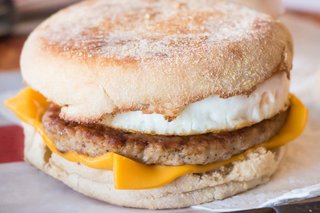
Practical tips to help you eat less fat, including saturated fat.
Eating lots of saturated fat can raise your cholesterol and increase your risk of heart disease.
Saturated fat is found in:
- butter, ghee, suet, lard, coconut oil and palm oil
- cakes
- biscuits
- fatty cuts of meat
- sausages
- bacon
- cured meats like salami, chorizo and pancetta
- cheese
- pastries, such as pies, quiches, sausage rolls and croissants
- cream, crème fraîche and sour cream
- ice cream
- coconut milk and coconut cream
- milkshakes
- chocolate and chocolate spreads
UK health guidelines recommend that the:
- average man should eat no more than 30g of saturated fat a day
- average woman should eat no more than 20g of saturated fat a day
It's also recommended that people should reduce their overall fat intake and replace saturated fat with some unsaturated fat, including omega-3 fats.
Tips to eat less fat
To help you cut the total amount of fat in your diet:
- compare food labels when you shop so you can choose foods that are lower in fat
- choose lower-fat or reduced-fat dairy products or dairy alternatives
- grill, bake, poach or steam food rather than frying or roasting
- measure oil with a teaspoon to control the amount you use, or use an oil spray
- trim visible fat and take the skin off meat and poultry before cooking it
- choose leaner cuts of meat that are lower in fat, such as turkey breast and reduced-fat mince
- make your meat stews and curries go further by adding vegetables and beans
- try reduced-fat spreads, such as spreads based on olive or sunflower oils
How to cut down on saturated fat
Here are some practical tips to help you specifically cut down on saturated fat.
At the shops
Nutrition labels on the front and back of packaging can help you cut down on saturated fat. Look out for "saturates" or "sat fat" on the label.
High: More than 5g saturates per 100g. May be colour-coded red.
Medium: Between 1.5g and 5g saturates per 100g. May be colour-coded amber.
Low: 1.5g saturates or less per 100g. May be colour-coded green.
Aim to choose products with green or amber for saturated fat.
There can be a big difference in saturated fat content between similar products.
Choose the food that's lower in saturated fat. Serving sizes can vary too, so make sure you're comparing like for like. The easiest way to do this is by looking at the nutritional content per 100g.
At home
Spaghetti bolognese: use a lower-fat mince, as it's lower in saturated fat. If you're not using lower-fat mince, brown the mince first, then drain off the fat before adding other ingredients. Alternatively, mix meat mince with a meat-free mince alternative.
Pizza: choose a lower-fat topping, such as vegetables, chicken, tuna and other seafood instead of extra cheese or cured meats like pepperoni, salami and bacon.
Fish pie: use reduced-fat spread and skimmed milk to reduce the fat in the mash and sauce.
Chilli: use lower-fat mince or mix in a meat-free mince alternative. Or, make a vegetarian chilli using mixed beans, some lentils and vegetables. Beans and lentils can count towards your 5 A Day, too.
Chips: choose thick, straight-cut chips instead of french fries or crinkle-cut to reduce the surface area exposed to fat. If you're making your own, cook them in the oven with a little vegetable oil and the skins on, rather than deep frying.
Potatoes: make your roast potatoes healthier by cutting them into larger pieces than usual and using just a little sunflower or olive oil.
Mashed potato: use reduced-fat spread instead of butter, and skimmed milk instead of whole or semi-skimmed milk.
Chicken: go for leaner cuts, such as chicken breast. Before you eat it, take the skin off to reduce the saturated fat content.
Bacon: choose back bacon instead of streaky bacon, which contains more fat. Grill instead of frying.
Eggs: prepare eggs without oil or butter. Poach, boil or dry fry your eggs.
Pasta: try a tomato-based sauce on your pasta. It's lower in saturated fat than a creamy or cheesy sauce.
Milk: use skimmed milk on your cereal and in hot drinks. It has about half the saturated fat of semi-skimmed.
Cheese: when using cheese to flavour a dish or sauce, try a strong-tasting cheese, such as reduced-fat mature cheddar, as you'll need less. Make cheese go further by grating instead of slicing it.
Yoghurt: choose a lower-fat and lower-sugar yoghurt. There can be a big difference between different products, so check the nutrition label.
Eating out
Tips to help you cut down on saturated fat when eating out.
Coffee: swap large whole milk coffee for regular "skinny" ones. Avoid adding cream on top.
Curry: go for dry or tomato-based dishes, such as tandoori or madras, instead of creamy curries like korma, pasanda or masala. Choose plain rice and chapatti instead of pilau rice and naan.
Kebabs: go for a shish kebab with pitta bread and salad rather than a doner kebab.
Chinese: choose a lower-fat dish, such as steamed fish, chicken chop suey or szechuan prawns.
Thai: try a stir-fried or steamed dish containing chicken, fish or vegetables. Watch out for curries that contain coconut milk, which is high in saturated fat. If you choose one of these, try not to eat all the sauce.
Snack time: swap foods high in sugar, salt and fat, such as chocolate, doughnuts and pastries, for:
- some fruit
- wholegrain toast
- low-fat and lower-sugar yoghurt
- a small handful of plain, unsalted nuts
- a currant bun
- a slice of fruit loaf
- a slice of malt loaf